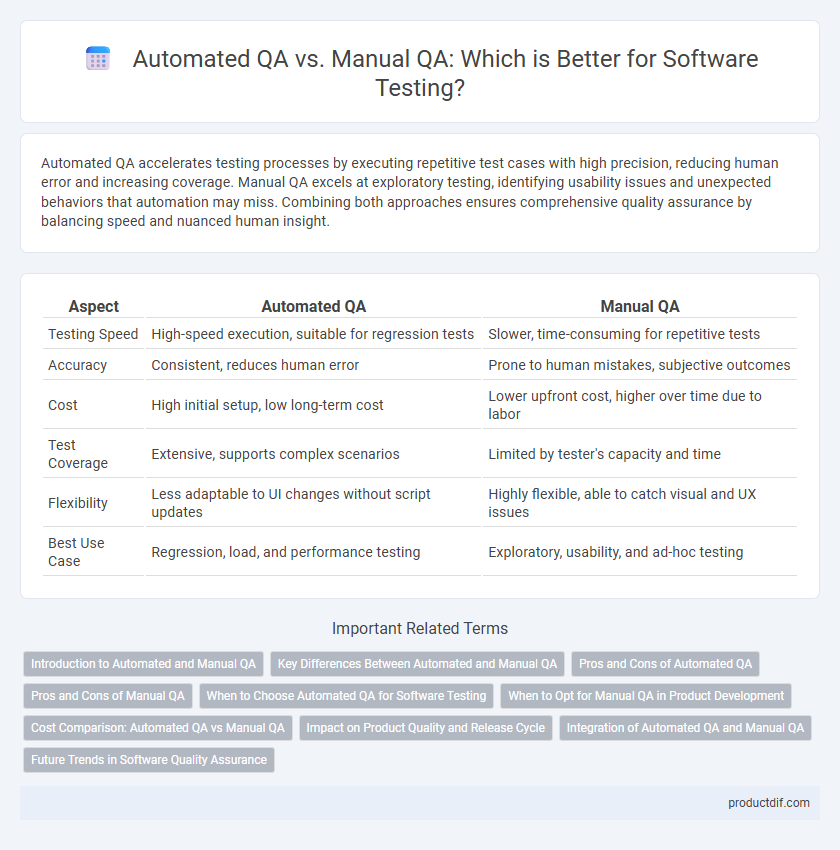Automated QA accelerates testing processes by executing repetitive test cases with high precision, reducing human error and increasing coverage. Manual QA excels at exploratory testing, identifying usability issues and unexpected behaviors that automation may miss. Combining both approaches ensures comprehensive quality assurance by balancing speed and nuanced human insight.
Table of Comparison
| Aspect | Automated QA | Manual QA |
|---|---|---|
| Testing Speed | High-speed execution, suitable for regression tests | Slower, time-consuming for repetitive tests |
| Accuracy | Consistent, reduces human error | Prone to human mistakes, subjective outcomes |
| Cost | High initial setup, low long-term cost | Lower upfront cost, higher over time due to labor |
| Test Coverage | Extensive, supports complex scenarios | Limited by tester's capacity and time |
| Flexibility | Less adaptable to UI changes without script updates | Highly flexible, able to catch visual and UX issues |
| Best Use Case | Regression, load, and performance testing | Exploratory, usability, and ad-hoc testing |
Introduction to Automated and Manual QA
Automated QA utilizes software tools and scripts to execute tests, enabling faster, repetitive, and consistent testing processes, especially effective for regression and performance testing. Manual QA relies on human testers to explore and identify defects through intuitive, exploratory, and usability testing, which is crucial for uncovering user experience issues and complex scenarios. Combining both approaches ensures comprehensive quality assurance by leveraging automation speed and manual insight.
Key Differences Between Automated and Manual QA
Automated QA utilizes scripted tests and software tools to execute repetitive testing tasks rapidly and accurately, significantly increasing test coverage and reducing human error. Manual QA relies on human testers to explore and interact with the software, enabling the detection of user interface issues, usability problems, and context-specific bugs that automated scripts might miss. Key differences include speed, scalability, accuracy, and flexibility, with automated QA excelling in regression and performance testing, while manual QA is preferred for exploratory and ad-hoc testing scenarios.
Pros and Cons of Automated QA
Automated QA offers faster test execution, increased test coverage, and repeatability, making it ideal for regression testing and large-scale projects. However, it requires significant upfront investment in test script development and maintenance, and may struggle with complex, exploratory, or UI-centric test cases. Balancing automation with manual QA ensures thorough validation, leveraging automation's speed and manual testing's adaptability.
Pros and Cons of Manual QA
Manual QA offers precise detection of user interface issues and intuitive usability flaws that automated tests might overlook. It allows for flexible, real-time adaptation to unexpected test scenarios, enhancing the identification of complex bugs. However, manual testing is time-consuming, prone to human error, and less efficient for repetitive tasks when compared to automated QA processes.
When to Choose Automated QA for Software Testing
Automated QA is ideal when testing requires repetitive execution, large-scale data input, or regression testing to quickly identify defects and ensure consistent results. It excels in environments with frequent code changes and extensive test coverage needs, reducing human error and accelerating release cycles. Opt for Automated QA when high precision, scalability, and test efficiency are critical for software quality assurance.
When to Opt for Manual QA in Product Development
Manual QA is essential when testing requires human intuition, subjective judgment, or exploratory analysis that automated scripts cannot replicate. It proves crucial for assessing user experience, design elements, and complex workflows in early-stage product development. Manual testing is preferred for validating nuanced functionality, usability, and unpredictable user interactions before scaling automation efforts.
Cost Comparison: Automated QA vs Manual QA
Automated QA significantly reduces long-term costs by enabling faster execution of repetitive test cases and minimizing human error, while manual QA incurs higher labor expenses due to the need for continuous human involvement. Initial investments in test automation tools and scripting can be substantial, but these costs are offset over time by increased test coverage and reusability. Manual QA remains cost-effective for exploratory and ad-hoc testing scenarios where flexibility outweighs speed and volume.
Impact on Product Quality and Release Cycle
Automated QA accelerates the release cycle by enabling continuous testing and rapid detection of defects, significantly reducing manual errors and increasing test coverage. Manual QA provides nuanced insights through exploratory testing and usability assessments, which automated scripts may miss, enhancing overall product quality. Balancing automated and manual QA optimizes both speed and depth of testing, leading to higher quality releases and more efficient development workflows.
Integration of Automated QA and Manual QA
Integrating automated QA with manual QA enhances software testing by combining the efficiency and speed of automation with the contextual understanding and adaptability of manual testing. Automated tests excel at repetitive regression checks and performance validation, while manual testing focuses on exploratory, usability, and complex scenario evaluations. This hybrid approach ensures comprehensive test coverage, improved defect detection, and faster release cycles in agile development environments.
Future Trends in Software Quality Assurance
Automated QA leverages AI-driven testing tools and continuous integration pipelines to enhance efficiency and accuracy in software validation, reducing human error and accelerating release cycles. Manual QA remains essential for exploratory testing and usability assessments, offering nuanced insights that automation struggles to replicate. Future trends indicate a hybrid approach combining AI-powered automation with skilled manual testers to ensure comprehensive quality assurance in increasingly complex software environments.
Automated QA vs Manual QA Infographic

 productdif.com
productdif.com